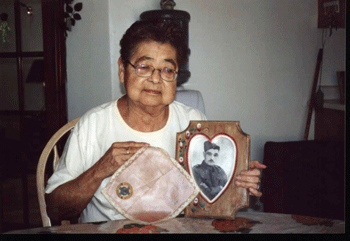Mi'kmaq woman fondly recalls fallen father
Writers Note: Stories of our Aboriginal Veterans should always be told and never forgotten. This is one story of a Mi’kmaq Veteran who paid the ultimate sacrifice for our freedom. This story was originally written in November 2002. Since then, Caroline has passed away, but her father’s ultimate sacrifice will never be forgotten.
By George Paul
You could see it in Caroline Young’s eyes, the great admiration and love she had for her father. She was only ten when her father went missing in action on June 7, 1944, but cherishes the little memories she had of her father. Detail would be revealed later about the horrific death Private Charles Doucette faced at the hands of the Nazis.

Caroline Young holds a picture of her father and a handkerchief that he sent to her in 1943.
Caroline and her three sisters, Racheal, Elizabeth, and Marie resided in Membertou First Nations, Nova Scotia during the Second World War. Caroline being the oldest, recalls her father more clearly. Caroline remembers her father always in military uniform because she remembers those loud boots. The most vivid and joyous recollection Caroline had was when her father came home one evening with many gifts. She remembers the table and chairs, the dolls and treats her father had bought. She vaguely remembers the day her father left for war and couldn’t understand why her mother, Mary Jane, was crying. She also didn’t understand why the people in the community were there to see Charles’ departure. That vague memory would be Caroline’s last memory she would have of her father.
Private Charles Doucette enlisted in the North Nova Scotia Highlanders Regiment when World War II broke out. He was sent to England with other men from his regiment where they were trained for the eventual invasion of France. The coast of Normandy was chosen as the appropriate site to launch the attack.
On D-Day June 6, 1944, more than 130,000 Americans, British and Canadian troops stormed the beaches of Normandy in what was considered history’s biggest amphibious operation. The event would be infamously known as the Battle at Normandy.
During the attack of the Nazis, it is believed that Private Charles Doucette was captured along with other Canadian soldiers. Not a word would be known about their fate until nearly a year later.
Investigation later revealed that Kurt Meyer, Commander of the 25th S.S. Panzer Grenadier Regiment of the 12 S.S. Panzer Division, ordered the Canadian prisoners to be executed. Nearly a year later the bodies were discovered at Abbaye d’Ardenne.
“It was determined by the pathologist that all had died of head wounds from bullets fired at the base of the skull or by the use of a blunt instrument such as a rifle butt or a club, meaning that some of the men had been clubbed to death,” (Tremblay).
A total of 20 bodies were discovered at the Abbaye. The bodies were re-buried at the Canadian military cemetery of Beny-sur Mer, not far from Abbaye. Meyer was only sentenced to 9 years in prison for the brutal murders he committed. He spent the rest of his life peacefully with his family until his death in 1962.
Caroline visited the Canadian cemetery at Beny-sur Mer in 1989 for the first time with her sisters. She went back again in 1997 with two of her children and her sister Racheal.
Caroline is 68 now and doesn’t think she’ll make the trip again. She still has the handkerchief her father sent her in 1943 and remembers the letters she used to receive, even though Pte. Doucette didn’t know how to write. Caroline later met the man who wrote the letters. Every letter held the same message, “I love you very much, please take care of your sisters.”
Caroline started her own craft shop after her husband, Charlie, died over 12 years ago. Caroline plans on making a memorial for her father so that the Young family and the Mi’kmaq Nation will never forget who Private Charles Doucette was – a hero.